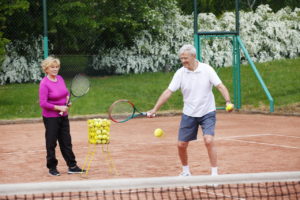
Endurance activities, often referred to as aerobic, increase your breathing and heart rates. These activities help keep you healthy, improve your fitness, and help you perform the tasks you need to do every day. Endurance exercises improve the health of your heart, lungs, and circulatory system. They also can delay or prevent many diseases that are common in older adults such as diabetes, colon and breast cancers, heart disease, and others. Physical activities that build endurance include:
- Brisk walking or jogging
- Yard work (mowing, raking)
- Dancing
- Swimming
- Biking
- Climbing stairs or hills
- Playing tennis or basketball
Increase your endurance or “staying power” to help keep up with your grandchildren during a trip to the park, dance to your favorite songs at a family wedding, and rake the yard and bag up leaves. Build up to at least 150 minutes of activity a week that makes you breathe hard. Try to be active throughout your day to reach this goal and avoid sitting for long periods of time.
Do a little light activity, such as easy walking, before and after your endurance activities to warm up and cool down.
Listen to your body: endurance activities should not cause dizziness, chest pain or pressure, or a feeling like heartburn.
Be sure to drink liquids when doing any activity that makes you sweat. If your doctor has told you to limit your fluids, be sure to check before increasing the amount of fluid you drink while exercising.
If you are going to be exercising outdoors, be aware of your surroundings.
Dress in layers so you can add or remove clothes as needed for hot and cold weather.
To prevent injuries, use safety equipment, such as a helmet when bicycling.
Your muscular strength can make a big difference. Strong muscles help you stay independent and make everyday activities feel easier, like getting up from a chair, climbing stairs, and carrying groceries. Keeping your muscles strong can help with your balance and prevent falls and fall-related injuries. You are less likely to fall when your leg and hip muscles are strong. Some people call using weight to improve your muscle strength “strength training” or “resistance training.”
Some people choose to use weights to help improve their strength. If you do, start by using light weights at first, then gradually add more. Other people use resistance bands, stretchy elastic bands that come in varying strengths. If you are a beginner, try exercising without the band or use a light band until you are comfortable. Add a band or move on to a stronger band (or more weight) when you can do two sets of 10 to 15 repetitions easily. Try to do strength exercises for all of your major muscle groups at least 2 days per week, but don’t exercise the same muscle group on any 2 days in a row.
Always remember to breathe normally while holding a stretch.
Talk with your doctor if you are unsure about a particular exercise.
For More Information About Exercise and Physical Activity
American Council on Exercise
888-825-3636 (toll-free)
[email protected]
www.acefitness.org
American Physical Therapy Association
800-999-2782 (toll-free)
